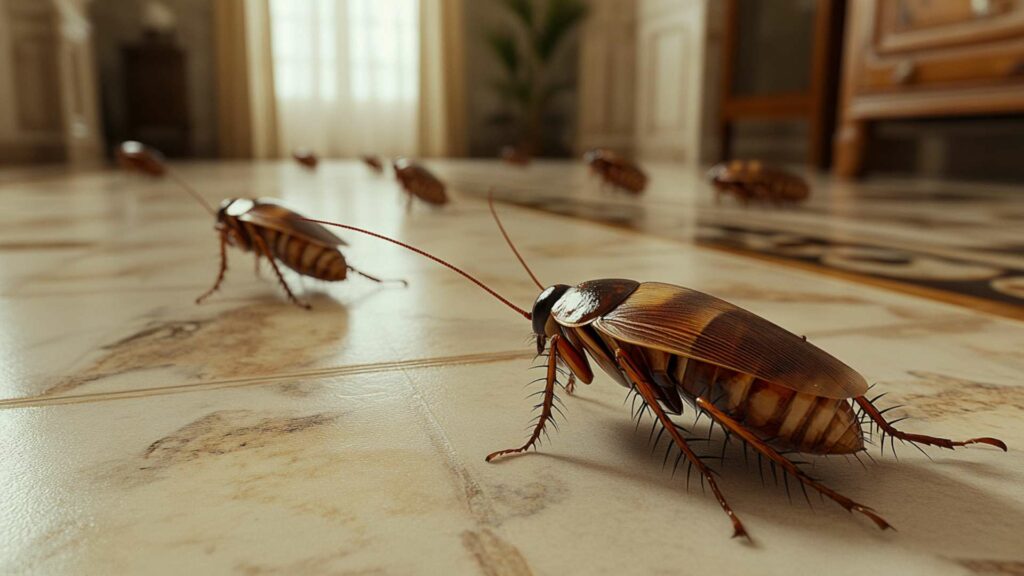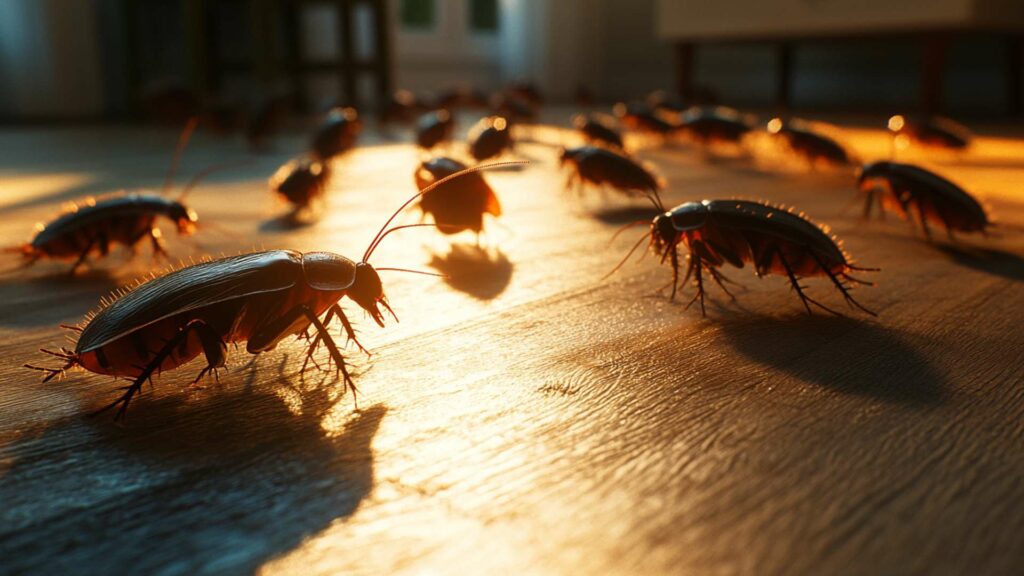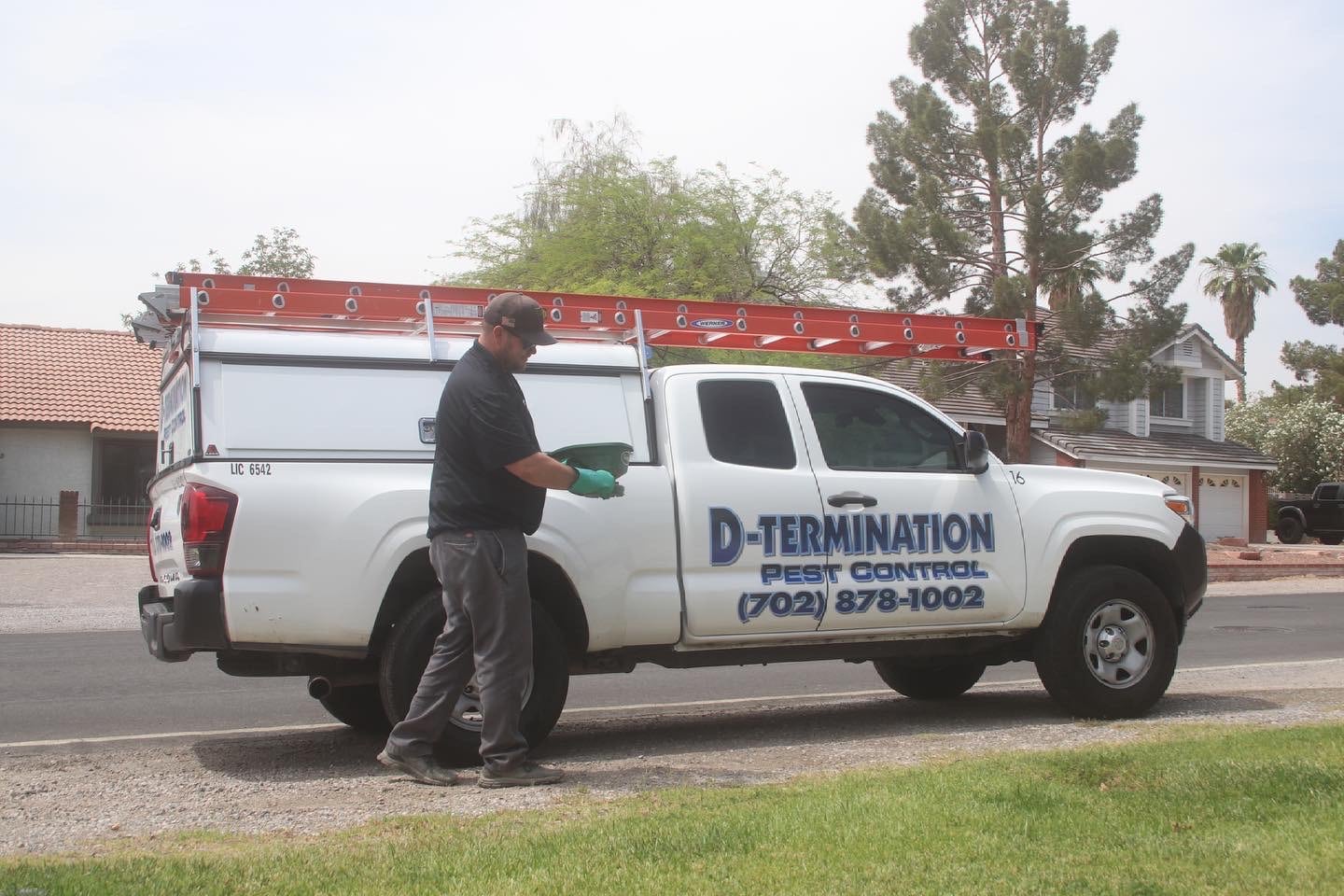Overview of roach eggs and their reproductive cycle
Roaches, those pesky pests that make our skin crawl, have an incredibly efficient reproductive cycle. Understanding how these critters reproduce is crucial in effectively combating them.
Female roaches lay eggs in clusters called egg cases or oothecae, which are protective casings for developing embryos. The number of eggs within each egg case also varies depending on the species of roach.
For instance, German cockroaches can lay up to 40 eggs per ootheca, while the larger American cockroach can produce around 15 eggs per case. After a period ranging from a few days to several weeks, these egg cases hatch into nymphs – immature roaches that resemble adults but lack wings and reproductive capabilities.
Nymphs undergo multiple molting phases as they grow into adult roaches. It’s worth noting that the time it takes for an egg to develop into a mature adult varies based on environmental factors such as temperature and humidity levels.
Kick Roaches Out the Green Way! Take the first step towards eco-friendly pest control by exploring our tips on natural remedies and DIY roach control.
Importance of eliminating roach eggs to prevent infestations
You might wonder why it’s so vital to focus on eliminating roach eggs rather than solely targeting adult roaches. Well, here’s the thing: killing adult cockroaches doesn’t guarantee eradication because their offspring carry on the legacy of infestation. By tackling roach eggs head-on, you disrupt their reproductive cycle and prevent future generations kill cockroaches from hatching and multiplying.
Roach infestations can pose significant health hazards as these insects are known carriers of disease-causing pathogens such as salmonella and E.coli. Additionally, they trigger allergies in many people due to their shed skin and droppings.
By preventing infestations through the effective elimination of cockroach eggs, you safeguard your home or business environment from these harmful consequences. Now that we have a basic understanding of roach eggs and their critical role in infestations, let’s delve into the various methods and techniques for killing cockroach eggs and these sneaky invaders at their most vulnerable stages.
Identifying Roach Eggs
Description of Roach Egg Appearance and Characteristics
Roach eggs are tiny, oval-shaped structures that serve as the protective casing for developing roaches. They are usually brown or reddish-brown in color and have a smooth, shiny texture.
The size of the eggs varies depending on the roach species, but they are typically around 1 to 8 millimeters long. These resilient casings protect the roach embryos from external threats, including various pesticides.
When it comes to identifying cockroach eggs, it’s essential to know how many eggs and what they look like. Cockroach egg cases, also known as oothecae, vary in appearance depending on the species of cockroach.
For instance, German cockroaches produce smaller egg cases that are approximately 6-9 millimeters long and have a light brown color. American cockroaches, on the other hand, generate larger egg cases measuring around 8-13 millimeters long and have a darker reddish-brown hue.
Common Places Where Roach Eggs Are Typically Found

Cockroaches prefer warm and humid environments close to sources of food and water where they can lay their eggs undisturbed. Therefore, it’s crucial to be aware of common areas where you might find roach eggs in your home or business premises. One common hiding spot for roaches for laying eggs is dark cracks and crevices near kitchen cabinets or baseboards.
Roaches often deposit their egg cases in these secluded areas as they provide protection from predators while being in close proximity to potential food sources. Additionally, roaches may lay their eggs behind appliances such as refrigerators or stoves where warmth is generated.
Other potential locations include bathroom cabinets, pipe chases, utility rooms, or even inside electronic devices such as TVs or computers if there are sufficient heat and humidity levels. By familiarizing yourself with these common areas, you can better target your efforts in eliminating roach eggs and preventing future infestations.
Using Diatomaceous Earth to Dehydrate and Kill Roach Eggs
Explanation of How Diatomaceous Earth Works as a Natural Pesticide
When it comes to combating roach eggs, one effective natural method is using diatomaceous earth. But what exactly is diatomaceous earth and how does it work? Well, let me enlighten you.
Diatomaceous earth is composed of fossilized remains of tiny aquatic organisms called diatoms. These microscopic fossils have sharp edges that pierce the exoskeletons of insects like roaches, causing them to dehydrate and die.
This natural pesticide is safe for humans and pets, making it an appealing choice for many homeowners. The fine powder consistency allows diatomaceous earth to cling onto the bodies of pests, including roaches, as they traverse through treated areas.
Once coated in this powder, the insects begin to lose moisture rapidly due to the damage inflicted upon their exoskeletons. In effect, diatomaceous earth acts as a desiccant that dehydrates and kills cockroaches and their eggs.
Application Techniques for Effective Results
Now that you understand how diatomaceous earth works its magic to find cockroach eggs, let’s delve into the application techniques that will ensure you achieve effective results in eliminating roach eggs. First off, identify areas where roaches frequent or where you suspect they may have deposited their eggs inside your home. Common places include dark corners, crevices near pipes or baseboards, behind kitchen appliances, or bathroom fixtures – basically any moist areas are worth checking.
To apply the diatomaceous earth effectively, start by thoroughly cleaning these areas with a vacuum cleaner or a damp cloth if necessary. Once clean and dry, sprinkle a light dusting of diatomaceous earth directly onto surfaces where you suspect roach infestation or egg deposition.
Pay extra attention to cracks, crevices, and other hiding spots that roaches usually prefer. Remember to reapply diatomaceous earth after each cleaning session to keep the protective barrier intact.
Also, keep in mind that diatomaceous earth is most effective when it remains dry, so avoid using it in areas prone to moisture or heavy humidity. Act fast and consistently with this method, and you’ll soon see a significant decline in roach eggs and their subsequent hatchlings.
Utilizing Boric Acid to Eliminate Roach Eggs

Overview of Boric Acid’s Toxicity for Insects Like Cockroaches
Another natural weapon against roach eggs is boric acid. While the name may sound ominous, boric acid is actually a low-toxicity compound that effectively eliminates pests such as cockroaches’ eggs. This white powdery substance disrupts the metabolism of these pesky insects when they come into contact with it.
As a result, the baby roaches eventually die due to dehydration and starvation. Boric acid acts as an ingenious killer because female cockroaches are attracted to its scent.
These females unknowingly carry boric acid back to their nest inside egg capsules or on their bodies where the rest of the colony resides. The poison spreads through grooming activities and by feeding on contaminated feces or dead roaches, ultimately affecting other roaches including eggs.
Safe Application Methods in Areas Prone to Egg Deposition
To effectively utilize boric acid for eliminating roach eggs, you need to ensure safe application methods, especially in areas where these pests tend to deposit their eggs. As always, before applying any pest control substance indoors, clear away food items and thoroughly clean all surfaces where the application will take place.
To apply boric acid powder effectively: 1. Use gloves and a mask for protection.
2. Apply a thin layer of powder in areas where you suspect roach eggs or infestation, paying particular attention to cracks, crevices, and dark corners. 3. Keep the powder away from children and pets by applying it in unreachable spots or using bait stations specifically designed for boric acid.
4. Reapply as necessary after cleaning or every few weeks for long-term effectiveness. Remember, boric acid should be used with caution.
While it is relatively safe compared to other chemical pesticides, excessive exposure can still be harmful. By adopting these safe application techniques, you can successfully eliminate roach eggs without compromising the well-being of your loved ones or the environment.
Chemical Approaches to Eradicating Roach Eggs

Introduction to insect growth regulators (IGRs) for controlling roaches’ reproductive cycle
When dealing with a persistent cockroach infestation, it becomes crucial to address their reproductive cycle and prevent the development of new generations. This is where insect growth regulators (IGRs) come into play.
IGRs are synthetic chemicals designed to disrupt the growth and development of pests, including roaches. These substances mimic the hormones found in insects, interfering with their life stages and ultimately preventing them from reaching maturity.
Explanation of IGRs’ ability to disrupt the development of roach eggs
One significant advantage of using IGRs against roach eggs is their long-lasting effect. Female cockroaches lay oothecae, which are dark brown capsules containing multiple eggs.
By applying IGRs, you interrupt the normal embryonic development within these oothecae, leading to a failure in nymphal hatching. The targeted disruption prevents the next generation of cockroaches from successfully reaching adulthood and reproducing further.
Recommended IGR products and application guidelines
Several effective IGR products are available in the market for tackling cockroach infestations. One such product is methoprene, which specifically targets insect larvae and prevents them from molting into adults. Another commonly used IGR is hydroprene, which acts similarly by impeding insect growth but also affects adult female reproduction.
When applying IGRs, it’s crucial to follow the manufacturer’s instructions meticulously. Depending on the product type and formulation, you may need to mix it with water or use ready-to-use sprays or baits directly on potential breeding sites or areas prone to egg deposition—such as cracks, crevices, and warm sheltered areas like kitchens or bathrooms.
Insecticidal sprays targeting roach eggs
In addition to IGRs, there are insecticidal sprays available that specifically target roach eggs. These sprays contain chemicals such as pyrethroids, which have potent insecticidal properties. Pyrethroids effectively kill cockroach eggs upon contact and also provide residual protection against future infestations.
When using insecticidal sprays to combat roach eggs, it is important to consider proper timing and coverage areas. Apply the spray directly onto the egg clusters, making sure to thoroughly cover all visible oothecae.
Pay special attention to potential hiding spots like behind appliances, in cracks and crevices, under sinks, or along baseboards. Be cautious not to use these sprays on surfaces that come into direct contact with food or utensils and always follow the instructions provided by the manufacturer for a safe and effective application.
By utilizing both IGRs and targeted insecticidal sprays, you can significantly disrupt the development of roach eggs within your living environment. Remember that different cockroach species may have varying sensitivities or resistances to certain chemicals, so it is advised to consult with pest control professionals for tailored advice when dealing with severe infestations.
Cleaning Practices for Eliminating Roach Eggs
Thorough cleaning routines in infested areas
When dealing with a roach infestation, thorough cleaning becomes crucial in eliminating roach eggs. Start by decluttering the affected area to remove any potential hiding spots. Pay close attention to cracks and crevices where these resilient pests love to lay their eggs.
Use a vacuum cleaner with a nozzle attachment to suck up any visible egg sacs or debris. Remember, proper sanitation is key in disrupting the roach reproductive cycle.
Identification of potential hiding spots for egg clusters
To effectively combat cockroach eggs, it’s important to identify their favorite hiding spots. These sneaky creatures tend to deposit their eggs in dark, hidden areas that are close to food sources and moisture. Check behind appliances like refrigerators and stoves, as well as under sinks and inside cabinets.
Look out for egg capsules resembling small brownish ovals that can contain up to 40 eggs each! By inspecting and targeting these specific areas, you can significantly reduce the chances of future infestations.
Effective cleaning agents, such as bleach or vinegar solutions
When it comes to eliminating roach eggs, utilizing effective cleaning agents is essential. Two common options are bleach and vinegar solutions.
For bleach-based cleaners, make sure to dilute them properly according to the instructions provided on the label. Apply the solution generously on surfaces where egg sacs might be present, allowing it enough time (around 10-15 minutes) for maximum effectiveness before wiping away any residue.
Alternatively, vinegar solutions can also be used as a natural cleaning agent with anti-bacterial properties. Mix equal parts of water and distilled white vinegar in a spray bottle and apply it directly onto potentially infested areas while paying particular attention to crevices where eggs could be found.
Allow the solution to sit for a few minutes before wiping it clean. Remember, these cleaning agents help eliminate both visible and invisible remnants of cockroach eggs, ensuring a thorough cleansing process.
Preventive measures against future infestations
Tips on maintaining cleanliness and minimizing food
Preventing future roach infestations requires diligent maintenance and an understanding of their habits. First and foremost, maintain a clean living environment by regularly sweeping and mopping floors to remove any food particles that might attract roaches.
Store all food in airtight containers, including pet food, to limit access for these unwelcome guests. Additionally, fix any leaks or sources of moisture to make your home less appealing to roaches who thrive in damp environments.
Seal off potential entry points by caulking gaps around baseboards, pipes, and windows. Install door sweeps to block any potential routes for the critters to enter your house or home.
Regularly inspect areas where they commonly hide near appliances or in cabinets. And lastly, keep a vigilant eye out for signs of roach activity as early detection is key in preventing an infestation and preventing cockroaches from taking hold.
Conclusion
By following these cleaning practices diligently and incorporating preventive measures into your daily routine, you can effectively get rid of your home of cockroach eggs and minimize the risk of future infestations. Act fast when dealing with roach eggs as they have the potential to hatch quickly and lead to a full-blown infestation if not addressed promptly.
Remember that knowledge is power when it comes to dealing with pests like roaches – learn about their habits, target their hiding spots during cleaning efforts, and maintain cleanliness consistently. With determination and the right approach, you can achieve a pest-free environment that will leave you feeling at ease in your own home.
Choose D-Termination, Las Vegas’ Premier Pest Control, to eradicate cockroaches!

If you’re dealing with cockroach problems, fear not, as D-Termination is here to assist. Our expert team specializes in eliminating cockroach infestations, restoring cleanliness and peace of mind. Bid farewell to cockroaches—select D-Termination for effective pest control today!
To book your cockroach control service and reclaim your space from these persistent pests, contact us at 702-919-6310 or visit dtermination.com.
Frequently Asked Questions:
Insecticides designed for cockroaches can help kill roach eggs.
Certain insecticides and natural repellents can be used to kill roach eggs.
Cockroach egg sacs can be destroyed by scraping or using insecticides.
It is best not to squish cockroach eggs as it can release harmful bacteria and potential allergens. Instead, focus on eliminating them with appropriate methods.







